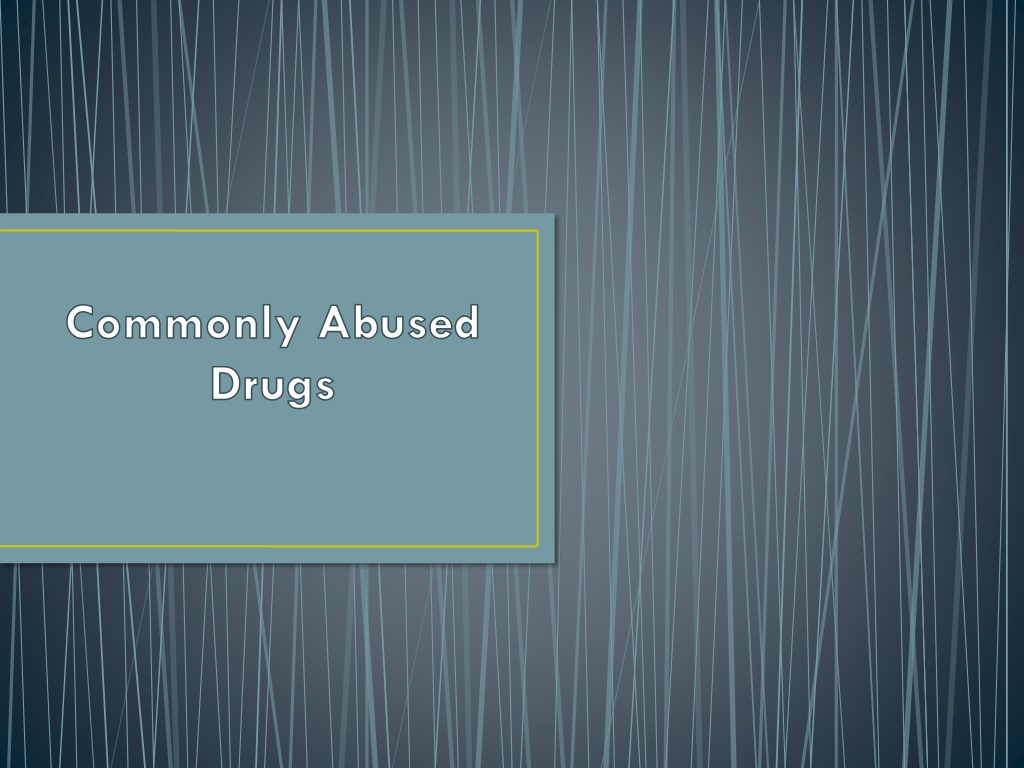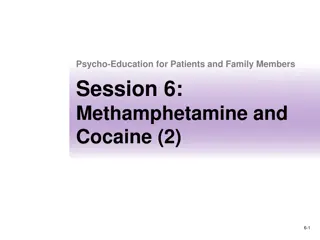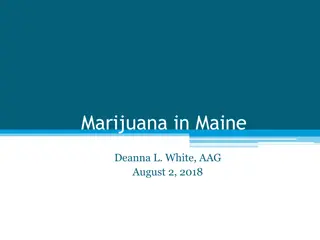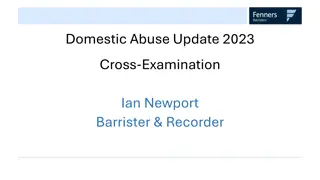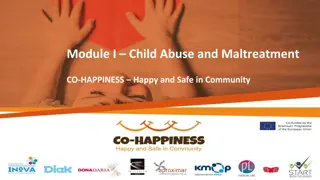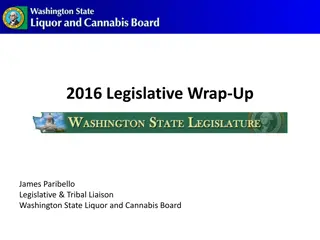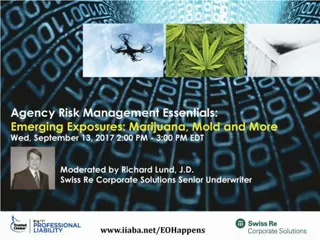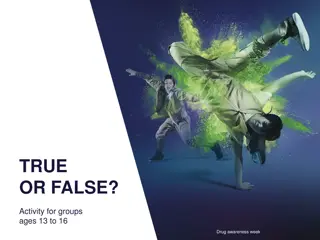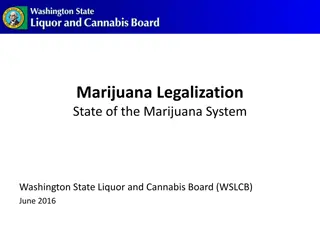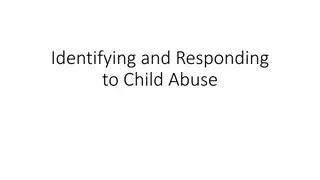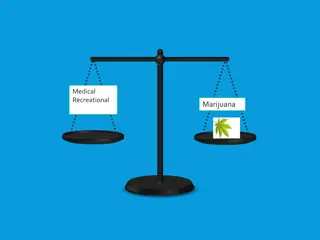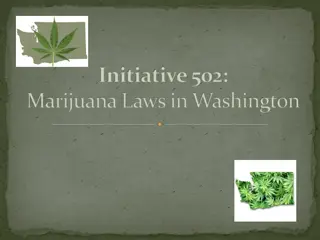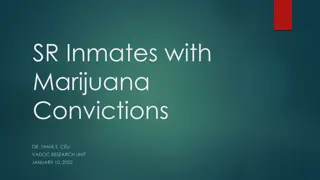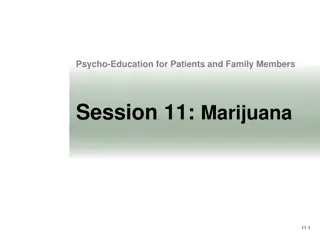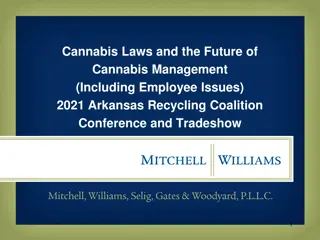Understanding Marijuana Abuse and Its Effects
Addiction to drugs like marijuana is a chronic brain disease that can lead to harmful consequences. Experimentation with drugs can escalate to addiction, affecting behavior and brain function. Marijuana, a commonly abused drug, alters the mind by interacting with receptors in the brain. Short-term effects include impaired thinking, while long-term effects can permanently alter brain function and affect overall health.
Download Presentation

Please find below an Image/Link to download the presentation.
The content on the website is provided AS IS for your information and personal use only. It may not be sold, licensed, or shared on other websites without obtaining consent from the author. Download presentation by click this link. If you encounter any issues during the download, it is possible that the publisher has removed the file from their server.
E N D
Presentation Transcript
Commonly Abused Drugs
Addiction- Behavior or Disease? Support for Behavior Support for Disease A chronic, often relapsing brain disease that causes compulsive drug seeking and use, despite harmful consequences to the addicted individual and to those around him or her. (NIDA) Even though the first time a person takes a drug, it is often by choice to achieve a pleasurable sensation or desired emotional state we now know from a large body of research that this ability to choose can be affected by drugs. And when addiction takes hold in the brain, it disrupts a person s ability to exert control over behavior reflecting the compulsive nature of this disease. It is a choice and you have control the first time you try a drug. A disease involves physiological malfunction, the proof of brain changes shows no malfunction of the brain.
So, does experimenting with drugs lead to addiction?
What is Marijuana? Plant: Cannabis Sativa Mixture of dried leaves, stems, seeds, flowers Hash/Hashish- most potent forms Psychoactive Drug Alters the mind Active Chemical is THC delta-9-tetrahydrocannabinol Most used illegal [illicit] substance on the globe and in the U.S.
What does it do in your body? Generally smoked THC passes from the lungs to the bloodstream where it is pumped throughout the body by the heart In the brain: Connects with receptors/nerve endings These particular receptors control: coordination, thought, memory, concentration, sensory and time perception, and pleasure This interaction is what causes the high Then it is absorbed in fatty tissue
Short Term Effects Difficulty in thinking and problem solving Problems with memory and learning Loss of coordination Distorted perception Impaired driving
Long Term Effects Alters the brain permanently Affects areas of the brain that control stress, motivation and reward Can lead to fertility problems Affects ovulation & sperm production Increased respiratory problems Decreased blood pressure Body s ability to fight off infection is weakened Emotional problems such as depression and anxiety Amotivational Syndrome???
Dangerous? Physical implications to your health Impaired decision making Career/Athletic aspirations Drug testing Legal repercussions Gateway drug
Marijuana Legalization Status Information above is accurate as of January 20, 2015 Forest Green= Medical Marijuana Legalized Lime Green= Marijuana legalized for medical/recreational use Grey= No laws legalizing Marijuana
Connection to Other Drugs 99.9% of cocaine users first abused drug was marijuana Teenagers (12-17) that have abused marijuana are 85 times more likely to use cocaine than those that don t A federal report released concludes the younger children are when they first use marijuana, the more likely they are to use cocaine and heroin and become dependent on drugs as adults.
Synthetic Marijuana (Spice, K2, etc.) Refers to a wide variety of herbal mixtures that produce experiences similar to marijuana (cannabis) and that are marketed as "safe," legal alternatives to that drug. Contains dried, shredded plant material and chemical additives that are responsible for their psychoactive (mind-altering) effects. Users report experiences similar to those produced by marijuana elevated mood, relaxation, and altered perception and in some cases the effects are even stronger than those of marijuana. Some users report psychotic effects like extreme anxiety, paranoia, and hallucinations.
How is it used? Some Spice products are sold as incense, but they more closely resemble potpourri. Like marijuana, Spice is abused mainly by smoking. Sometimes Spice is mixed with marijuana or is prepared as an herbal infusion for drinking.
Overdoses Spice abusers who have been taken to Poison Control Centers report symptoms that include rapid heart rate, vomiting, agitation, confusion, and hallucinations. Spice can also raise blood pressure and cause reduced blood supply to the heart (myocardial ischemia), and in a few cases it has been associated with heart attacks. Regular users may experience withdrawal and addiction symptoms. August 14, 2014- http://www.today.com/health/synthetic-pot-warning-spice- users-dont-how-deadly-drug-can-1D80058128
Cocaine Dangerous stimulant made from dried leaves of the coca plant Inhaled, snorted, smoked [crack] Affects the CNS Intense power, energy [the high] Extremely addictive After one use, a person can become painfully addicted Very short effects in body [5-10 minutes] Coke crash - leaves user wanting more
Ecstasy Synthetic Club drug Powder, capsules or tablets Combination of hallucinogen & stimulant Extreme emotions [+/-] Dry mouth, cramps, blurred vision, chills, sweating, nausea, generally causes jaw to clench Effects serotonin levels in the brain Dehydration overheats the body, raised heart rate permanent damage or death
Heroin Dried milk of opium poppy [narcotic] Ranges from light dark & powder tar-like substance Depressant; downer Burst of a euphoric high followed by warm feeling, drowsiness, nausea, stomach cramps and drowsiness On the Nod - alternate awake & drowsy state Extremely addictive Severe withdrawal Extremely likely to OD
Locally- May 2014 Chief of Prosecution Matthew Weintraub said heroin is a major problem in Bucks County with rising number of casualties emerging in the recent years, mostly among young people. Weintraub said the number of deadly overdoses rose from 19 in 2011 to 38 in 2012, and another 38 in 2013. So far in 2014 there has been six overdoses reported, two of which were fatal, he said. According to the Intelligencer in August 2014, there were 858 people addicted to heroin who tried to get help in 2013-2014. In the previous year, 742 people had sought help.
January 5, 2015- The Intelligencer The article discussed drug addiction and found of the drug addicts in Bucks County, Heroin was of the drug of choice.
LSD [Acid] Man-made hallucinogen Distorts the senses [usually within 30-90 mins.] Hallucinations, seeing colors/objects/people that are not actually present, melting walls, loss of sense of time A trip can last 12 hours or more Effects are unpredictable Bad trips can cause frightening/scary delusions Flashbacks up to a year later [1-time user] NOT considered addictive
Methamphetamine Highly addictive stimulant Crystal powder, rock form Initial euphoric rush or flash , After that user has delusions, violent/aggressive behaviors, paranoia, drowsiness, imagined insects crawling under skin Tolerance for the drug builds quickly
Conclusion Make healthy & SMART decisions You NEVER know exactly what you are putting into your body or how you will react Don t be a statistic Think of the repercussions, think of those worst-case-scenarios , how would your loved ones react if you were gone tomorrow?
